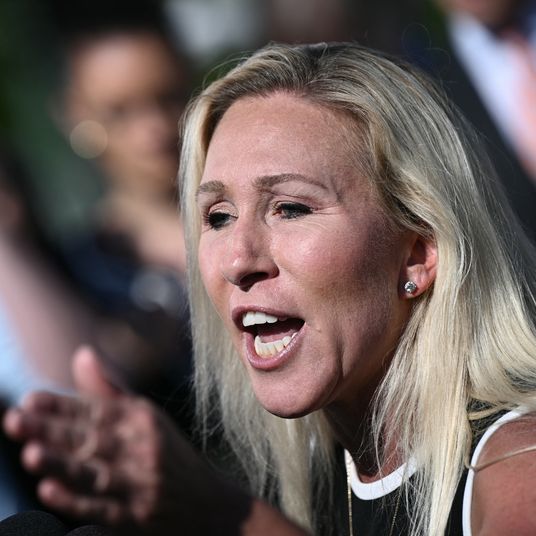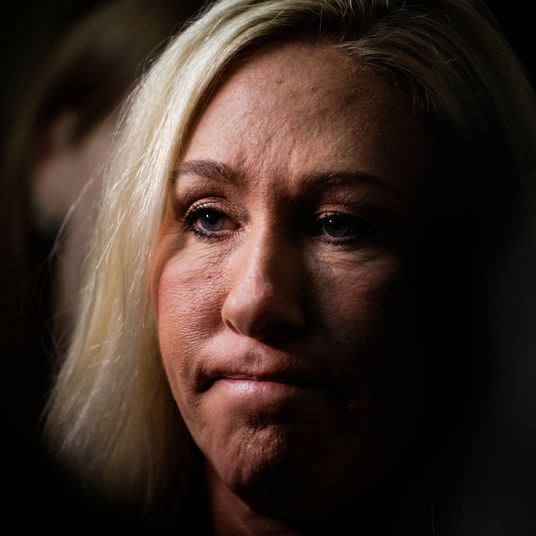
Despite the cold, gray weather in January, I ordered an iced coffee at a café on the Columbia University campus so that I could get a plastic cup. It was an ordinary cup, one of dozens like it that I will use once and throw into a recycling bin this year, where it will be reprocessed or, more likely, wind up in a landfill. “You look at this plastic material and it seems pretty flat and glossy and smooth,” says Columbia researcher Naixin Qian, pointing to its outside. “But if you zoom in to a microscopic level, you will see a kind of roughness.” Over its life span, she explains, exposure to ozone, oxygen, and sunlight can cause some of the chemical bonds of the cup’s polymer resin to wear. Tiny pieces of the cup’s plastic can break off the rough surface and shed into whatever liquid is in there.
We have known for years that we are drinking, eating, and breathing in plastic. But a study published by Qian and her colleagues last month could change our understanding of just how much of it we are drinking. Qian’s team found that bottled water contains as much as 100 times more plastic than previously estimated. By looking at nanoplastics — particles less than one micrometer — they found that a bottle of water may contain as many as 240,000 particles per liter.
Qian, the study’s lead author, says that their research was primarily meant to prove a new method using laser microscopes to identify different types of plastic at the nano scale, where they are less than 1/70th the diameter of a human hair. With this technology, they plan to next look for nanoplastics in tap water — which is known to contain fewer plastic particles than bottled water — and in the human body itself.
According to Penn State Behrand professor Sherri Mason, the new research on nanoplastics may be a landmark in the decadeslong study of plastic pollution. So far, the impact of nanoplastics on human health has been unknown because they were too small for microplastic studies to identify. “You could tell that there’s a particle there, but you can’t say for sure that it’s plastic and you can’t say for sure what type of plastic it is,” Mason says.
Mason, who has researched microplastics in the Great Lakes, bottled water, and tap water, says that the Columbia nanoplastics study can help us find out what we all want to know about plastic pollution: How bad is it for the potential human-health impact?
Wei Min, the Columbia chemistry professor who co-invented the laser technique to identify nanoplastics, believes they could be quite bad for us. “Whatever microplastic is doing to human health, I will say nanoplastics are going to be more dangerous,” he told the Washington Post.
Nanoplastics in bottled water have already caught the public’s attention — opening up new questions on the potential dangers of eating plastic all the time and its presence in every corner of our world. The large majority of plastic we consume in our diets passes through us without harm. But some of the particles that remain have been linked to brain inflammation and damage at the cellular level. Microplastics have crept into heart tissue and traveled through the placenta into babies in utero. Soon, research on the nano level could help us understand if and how previously undetectable levels of plastic are impacting us. “You have to be able to say, ‘I know for sure that this is a nanoplastic, and I’m watching it go across the blood brain barrier, and I find it in the liver, and this is what it’s doing,’” Mason says. “And so you have to be able to have that specificity, that analytical ability, if you’re going to understand the impacts that this is having on human health.”
Scientists who study microplastics in the body are still trying to determine their full effect on human health and the threshold at which they may be dangerous. But we already have an understanding of how the chemicals used to treat plastic can affect us. Mason says that there are between 10,000 and 12,000 chemicals used in the manufacturing of plastics — including flame retardants, UV stabilizers, colorants, and antibacterials. Daily-use plastics are known to be treated with chemicals that disrupt the body’s endocrine system that regulates hormones, and those chemicals that can potentially glom onto microplastics that are leaching into the environment. Mason points to research showing increased risk of cancer from microplastic exposure, as well as obesity rates, autism, and ADHD. Finding a replacement for a plastic with adverse health effects is not always so easy. Take BPA, the compound found to potentially increase the risk of blood pressure, heart disease, and type 2 diabetes. “I was just opening a can of soup, and it says it is BPA free, and I just kind of rolled my eyes because it is a necessary component of polycarbonates,” says Mason. “And so they replaced BPA with BPS, which is known to have worse impacts on human health. And it’s because of the mechanism that chemicals are regulated in the United States. We’re chemical by chemical, and it’s an outdated paradigm, because these things get put onto the marketplace, and then you have to prove that they’re having a human health impact.”
Chelsea Rochman, a University of Toronto professor studying plastic pollution, notes that microplastics in our bodies have so far been linked to disruptions of the endocrine system and inflammation. “If it ends up in different parts of our body, our tissues, it’s a foreign particle,” she says. “It can cause inflammation, which can eventually lead to other kinds of stress in the human body.” In December, her team found microplastics in protein sources, from tofu and ground beef to Alaska pollock and Key West pink shrimp. (The plastics were unavoidable in all sources they studied, though the more processing the food went through, the more microplastic it contained. The worst culprit? Breaded shrimp.)
Despite these findings, it remains an uncertain time for the study of the health effects of micro- and nanoplastics. Though the answers are becoming clearer, the field has not been around long enough to get a complete picture of what plastics are doing inside us. Rochman, who worked on an assessment for the state of California to determine microplastic risks in aquatic environments, estimated that a more formal understanding of plastic risk in the human body may be “only a matter of three to seven years” away. “Some people will say that any amount of microplastic is too much,” she says. “But the reality is that a government body wants to know: At what amount do we act?”
In the interim, with a U.N. plastics pollution treaty stalled out, what is there to do? The idea of plastic bits in our bodies is a near-universal concern — shared by everyone from Marianne Williamson to Alex Jones. Some researchers I spoke to said they would not be making big changes to their diet, because the stuff is simply everywhere. Others advise simple, well-known solutions — like avoiding heating up plastic in the dishwasher or microwave, which can cause chemical molecules to move from the plastic into food or water. Rochman mentioned after-market filters for washing machines, one of the greatest sources of microplastic pollution that consumers can personally control. As is common in all matters of public health and pollution, change at the policy level to put filters on washing machines and for better stormwater capture to catch the startling high numbers of microplastic pollution from car tires would be the most effective method. “Once microplastics themselves get into the environment, I don’t know that the benefits would outweigh the costs for the amount of microplastics we would remove from the environment,” Rochman says.
Mason proposed choosing one plastic product at a time to reduce using to avoid the kind of anxiety that can stop you from making any changes at all. “It must become a game,” she says. “I started with the obvious ones like bags and bottled water. And then I don’t buy tubes of toothpaste. Once I’m used to doing this, now what’s the next thing?” But thinking about plastic effects on the body goes beyond these choices at the grocery store. “People aren’t paying attention because they’re just focused on plastic as being a problem at the end of its life,” says Mason. “So when I see a plastic bottle, what I think about is that the people in Louisiana can’t breathe. I see these images of these real humans, and if I take that bottle of water, that’s what I’m contributing to. I’m preventing another human being from being able to breathe. So it’s not about what it’s doing to me, it’s thinking about it bigger than that and realizing every step of the way how it’s affecting people.”






























